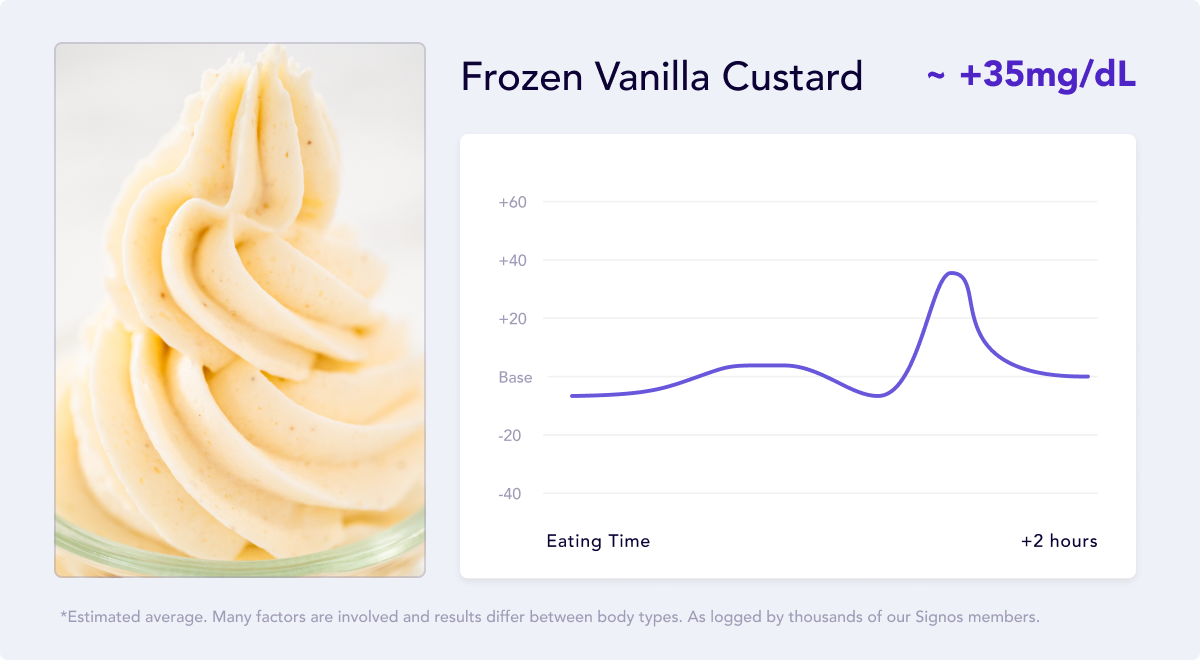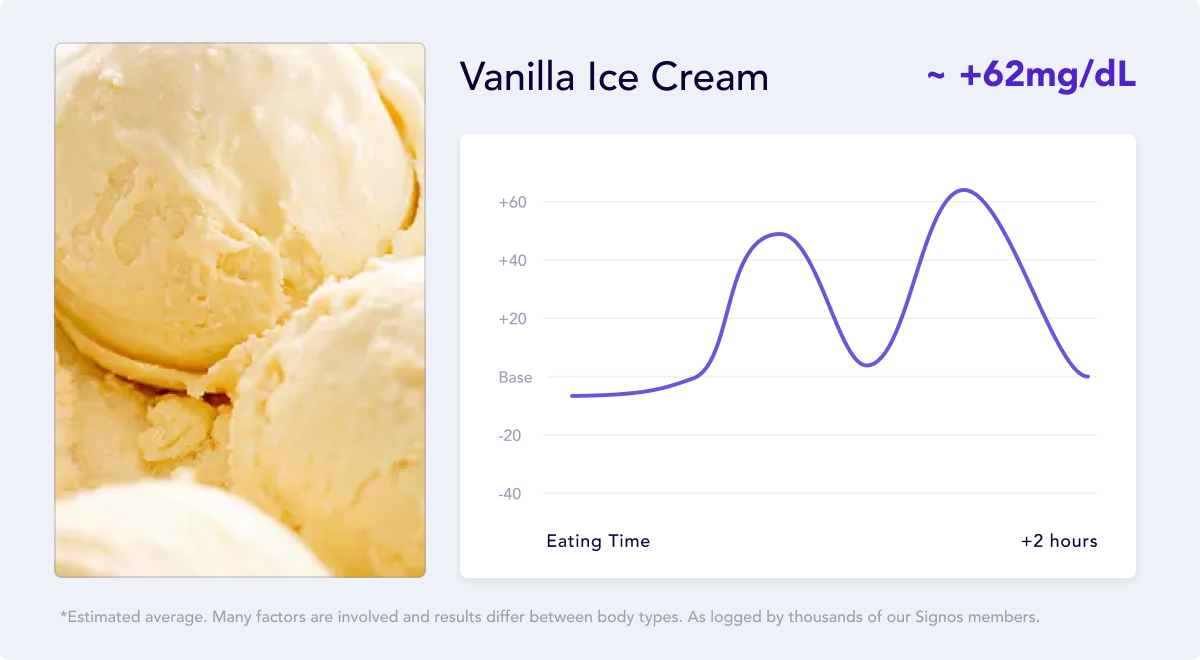Frozen Custard vs. Ice Cream: What Are the Differences?


When it comes to frozen treats, many people stock their freezers with healthy desserts like sherbet, sorbet, frozen yogurt, or soft-serve ice cream. However, the two most popular frozen treats might be ice cream and frozen custard. But don’t get them confused! While they’re both creamy and delicious, a few key differences set them apart and make them completely different desserts. Not sure which to incorporate into your diet? Don’t worry—we’ve got the scoop!
When it comes to frozen custard vs. ice cream, you'll primarily notice a different mouthfeel and texture. Ice cream is churned with lots of air to create a light consistency, while custard is made with egg yolk and less air to give it a rich, creamy texture. However, the differences go beyond the amount of air used in the production process. This article will highlight the main differences between the two frozen desserts and provide valuable insights into their impacts on your nutrition goals.

Discover how your body responds to what you eat, and make small changes to hit your health goals
View PlansWhat Is the Difference Between Ice Cream and Custard?
Ice cream and frozen custard differ primarily in their ingredients, flavor, and texture. While both frozen desserts have a milk and sugar base, custard recipes typically include heavy cream and emulsified egg yolks. These egg yolks give frozen custard a more velvety mouthfeel and richer flavor than traditional ice cream.
The amount of air used in the churning process also contributes to texture differences. Ice cream uses more air, giving it a lighter feel, while frozen custard uses less to create a more dense product.
What Is Ice Cream?
Ice cream is a popular American frozen dessert typically made with milk, cream, sugar, and additional flavorings as desired. You can make homemade ice cream with a resealable plastic bag, but ice cream requires lots of churning, so you may want to break out the ice cream maker.
As the ingredients are churned and allowed to freeze, air is incorporated into the ice cream to give it a smooth texture. Commercial ice cream-making machines freeze the mixture as it stirs to prevent ice crystals from forming in the ice cream base.
The United States Food and Drug Administration (FDA) mandates that ice cream contains 10-16% milk fat.1 Ice cream recipes with higher milk fat content tend to be smoother and creamier than those with less fat.
Ice cream is usually served in a bowl or cone and comes in various flavors. You might prefer the standard vanilla ice cream or want to spice it up with fun flavors like chocolate chip or cookie dough. Whatever flavor you choose can be served with toppings, like chocolate syrup, sprinkles, fruit, and nuts.
What Is Custard?
Custard is a traditional sauce made by blending eggs with milk or cream. It’s typically cooked on the stove or baked in the oven, where it thickens. On the other hand, soft-serve frozen custard is a chilled variation of the dessert.
Is custard ice cream? No, frozen custard’s ingredients include egg yolks in addition to milk, cream, sugar, and flavorings as desired.
As the mixture is churned, it’s allowed to freeze. However, stirring frozen custard involves much less air than ice cream, giving it a rich and creamy texture. Like ice cream, frozen custard can be served in cones or bowls with toppings like caramel, chocolate syrup, nuts, and fruit. Many people use frozen custard as the base for sundaes and milkshakes.
Is Custard Dairy Free?
While there are alternatives to custard that use non-dairy substitutions like coconut and almond milk, traditional frozen custard is not usually dairy-free. Frozen custard typically contains milk, cream, and eggs. These dairy products contribute significantly to the rich, creamy texture that eloquently defines frozen custard.
According to FDA standards, frozen custard must contain at least 10 percent milk fat and 1.4 percent egg yolk solids.1 Of course, the percentage of dairy ingredients in custard can vary, depending on the recipe used.
Which Is Better: Frozen Custard vs. Ice Cream?
If you’re in the mood for a frozen dairy dessert, you may wonder which is healthier: frozen custard or ice cream? In reality, both can be enjoyed as part of a well-balanced diet when consumed mindfully. It really comes down to personal preference. Custard is best known for its rich, creamy flavor and velvety texture, while ice cream has a lighter mouthfeel and many more available flavors.
However, if you’re pursuing specific health goals, the slight differences in their nutrition facts may impact your choice. Both desserts are indulgent treats with a common base of milk, cream, and sweeteners. The nutrition content will vary between brands and recipes, but they’re typically high in calories, saturated fat, and sugar.
Nutrition
While frozen custard and ice cream share similar ingredients, their ratios and production processes differ, resulting in different textures and nutritional breakdowns. For example, frozen custard typically includes more cream and less air during production. And because frozen custard recipes include egg yolks, they are more dense than ice cream and provide more protein.
Ice cream, on the other hand, is usually higher in calories. It also incorporates more air during mixing, resulting in a lighter and potentially less-satiating sweet treat. Ice cream also typically has a higher fat content than frozen custard, but it really depends on the brand.
If your health goals include losing weight or reducing your calorie intake, it’s best to read the nutrition labels when shopping at the grocery store. Compare custard vs. ice cream calories and choose the best ice cream or frozen custard that supports your individualized health goals.
The average serving size for these frozen desserts is 1/2 cup, but to standardize the comparisons, let’s look at the nutrition facts for 100-gram (g) servings of vanilla ice cream and vanilla frozen custard:2, 3
Glycemic Index
The glycemic index will vary between recipes and brands, but the average GI of chocolate ice cream is 68, making it a medium GI food.4 Frozen custard, on the other hand, contains more protein. Because of its nutritional breakdown, it usually has a lower GI than ice cream and will not cause a blood sugar spike as rapidly.


Vitamins
Frozen custard and ice cream have very similar vitamin profiles. Neither dessert contains significant amounts of any one vitamin, but both contain vitamins B2 and B12 and adequate amounts of vitamin A.
The average serving size for these frozen desserts is 1/2 cup, but to standardize the comparisons, let’s look at the vitamin content for 100-gram servings. Vitamins were highlighted based on their percent daily value (%DV):2, 3, 5
Minerals
Like their vitamin profiles, frozen custard and ice cream have similar mineral content. Since their main ingredients include milk and cream, the frozen desserts are rich in calcium and phosphorus. Other minerals include potassium, zinc, selenium, and sodium—although they don’t contain a significant amount compared to the percent daily values.
The average serving size for these frozen desserts is 1/2 cup, but to standardize the comparisons, let’s look at the vitamin content for 100-gram servings. Minerals were highlighted based on their percent daily value:2, 3, 5

Discover how your body responds to what you eat, and make small changes to hit your health goals
View PlansReferences
- CFR - code of federal regulations title 21.
- FoodData Central. Vanilla Ice Cream.
- FoodData Central. Vanilla Soft Serve.
- The University of Sydney GI Search. Ice Cream.
- FDA. Daily value on the nutrition and supplement facts labels.
Frequently Asked Questions
Is Gelato a Custard?
While gelato means ice cream in Italian, it isn’t necessarily the same as the traditional American ice cream at grocery stores. Gelato has a custard base and tends to contain less butterfat, intensifying the flavors.
Is Custard a Junk Food?
Frozen custard isn’t a nutrient-dense food, but that doesn’t mean it should be off-limits. A well-balanced diet incorporates all foods in moderation, accounting for nutrition needs, cultural traditions, and social opportunities. So, while frozen custard may not help you meet your micronutrient needs, it can still have a place in your healthy diet.
What’s the Difference Between Pudding and Custard?
Both pudding and custard recipes call for eggs. However, pudding typically uses starch as its thickening agent, whereas custard uses eggs.

